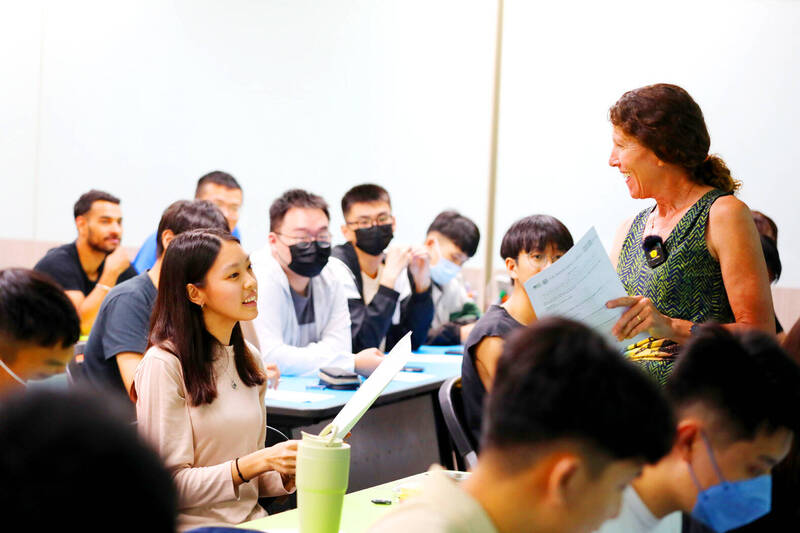《TAIPEI TIMES》 English-language courses below standard: auditor

A lecturer interacts with a student during an English as a medium of instruction class at National Sun Yat-sen University in an undated photograph. Photo courtesy of National Sun Yat-sen University
INADEQUATE PRACTICE: Students who had scored 15 in the General Scholastic Ability Test hardly ever speak English during EMI courses, an academic said
By Rachel Lin, Yang Mien-chieh and Esme Yeh / Staff reporters, with staff writer
At least half of the English-taught courses provided by universities under the Program on Bilingual Education for Students in College do not fit the definition of “English as a medium of instruction” (EMI), the National Audit Office said.
The program was launched by the Ministry of Education to enhance college students’ English proficiency via EMI courses and has so far been funded with NT$3 billion (US$92.5 million).
The ministry has commissioned the British Council to be a program consultant and invited experts from the University of Oxford to visit 16 universities in the program, and the experts have verified in a report that 90 percent of the teachers were competent at explaining professional course content in English and 70 percent achieved proficiency in English at the C1 or C2 level of the Common European Framework of Reference for Languages, the agency said.
However, 41 of the 80 EMI courses visited by the experts only met the EMI standard partially or not at all, mainly because the teachers took up most of the time giving lectures, the report said.
Without bilingual interaction from both sides, the teacher could not evaluate students’ learning progress and proficiency in English, it said.
To improve the quality of EMI courses, the ministry would provide teachers with further training on teaching methods, said Chen Hao (陳浩), section chief of the Higher Education Department at the ministry.
They would also be encouraged to observe fellow EMI teachers’ classes to learn from each other, he said.
On the other hand, the ministry has subsidized two more EMI resource centers this year in addition to the existing four centers, he said.
The centers would organize lectures, workshops and off-site trainings, as well as develop teacher communities, materials and lesson plans, to consistently boost EMI teachers’ teaching skills and course quality, Chen said.
The Program on Bilingual Education for Students in College covers from 2021 to 2025, with subsidies to seven “beacon universities” and 45 “beacon schools” affiliated with 24 universities.
The seven beacon universities are National Sun Yat-sen University, National Tsing Hua University, National Cheng Kung University, National Taiwan University, National Chengchi University, National Taiwan Normal University and National Taiwan University of Science and Technology (NTUST).
It is expected that by the end of this year, at least 25 percent of sophomores in beacon universities and schools could reach B2 or above proficiency in English listening, speaking, reading and writing, and that more than 30 percent of English classes are transformed into EMI courses.
Meanwhile, English-language teaching experts suggested that teachers take a communicative approach by encouraging students to speak in English without resorting to Chinese.
Providence University supervisor Michael Chen (陳振貴) said the spirit of EMI is using English only in lectures, teaching materials, teaching assessments, teacher-student interactions and demonstration of learning outcomes.
Chihlee University of Technology’s Applied English Department academic Chen Chao-ming (陳超明) said he had surveyed national university students who scored 15 in the General Scholastic Ability Test’s English subject and found that they hardly ever spoke English in EMI classes.
Learning tasks and activities must be developed to increase student talking time in classrooms, otherwise they would just let the teacher talk, he said, adding that teachers should change their thinking and deliver more student-centric lessons.
Teacher talking time should take about 30 percent of the time in a standard EMI course, while student talking time should take up about 70 percent, Chen added.
NTUST’s Graduate Institute of Biochemical Engineering associate professor Kao Chen-yu (高震宇), who is also a frontline EMI teacher, said that encouraging students to speak English (fluency and confidence) should come before correct grammar.
Additional reporting by Liu Wan-lin.
新聞來源:TAIPEI TIMES





















